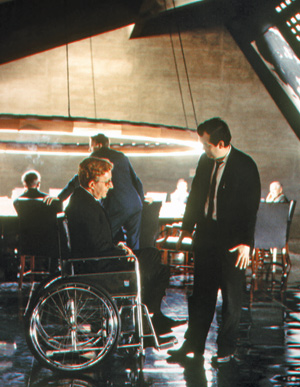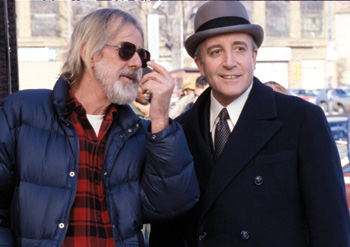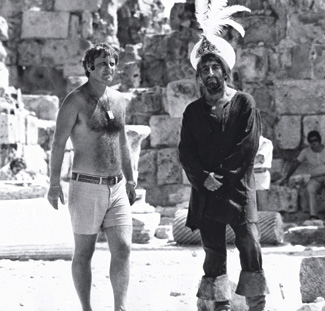BY STEVE POND
 Blake Edwards, on the set of The Party, said he and Sellers
Blake Edwards, on the set of The Party, said he and Sellers
"clicked on comedy." (Credit: MGM)
Peter Medak has spent the last hour telling a horror story. He begins with the sentence, "It was a nightmare," then tells of movie-star ego run amok—of firings, tardiness and outright sabotage, of insanity so excessive that it essentially killed the movie Medak was directing. It was so over the top that Gary Oldman once tried to work with Medak to turn the whole sordid account into a movie about the movie.
Now he finishes his tale, picks up a scrapbook with photos of that awful experience from 37 years ago, and opens it to the first page. There sits an 8-by-10 glossy of Peter Sellers, the actor whose craziness derailed Medak's movie, Ghost in the Noonday Sun, and drove the director to distraction, nearly wrecking his career.
Medak looks at the photo, smiles, and shakes his head. "He's a genius," he says softly, with a hint of sadness but not a trace of anger or recrimination directed at the man who made his life hell. "An absolute genius, Peter."
That, more often than not, is the story that directors tell about Peter Sellers. He was mad. He was difficult. He showed up late, and left early. He had strange color phobias. He could be cruel and capricious and impossible. He occasionally left broken men and shattered careers in his wake. But oh, was he a genius. And sometimes, somehow, that was enough.
"He was worth the trouble," says Joseph McGrath, who was fired from Casino Royale after getting into a physical altercation with the actor, but went on to make two more films with him and become a lifelong friend. "It's always worth it with people who are really, really good at what they do."
When he wanted to be, Sellers was indeed really, really good, and perhaps one of the finest screen comedians of the 20th century. From the protean British comedy of The Goon Show to his iconic turn as Inspector Clouseau in Blake Edwards' Pink Panther movies to his final, autumnal performance as Chauncey Gardner in Hal Ashby's Being There, he was nimble, graceful, witty, and hysterically funny.
"He was a great mover," says McGrath. "If you could shoot him full-length in a two-shot with somebody else, he was very beautiful in his movements, like Oliver Hardy. He played a skateboarding Queen Victoria on his knees in The Great McGonagall. We wheeled him around the studio, and he had great elegance."
Stanley Kubrick's longtime collaborator James B. Harris adds, "He was a comedian, but a great actor as well, so he was wonderful at just winging it. And because he was a great actor, other actors like James Mason didn't resent the fact that he was stealing all their scenes."
But offscreen, at the same time, Sellers could be haunted and depressed, wracked with doubt and prone to moodiness. "Like most clowns, he had a dark side," says Bryan Forbes, a friend of Sellers who directed him in The Wrong Box in 1966. "When he was on form, he was inspired—but he was mad, of course."
Part of the madness may have come from a weak heart that led to a series of heart attacks, the first while Sellers was making Billy Wilder's Kiss Me, Stupid in 1964. Heart problems eventually killed him in 1980 at the age of 54. "He was a doomed soul, of course," adds Forbes.

 GOOD BEHAVIOR: When a project was important to Sellers and
GOOD BEHAVIOR: When a project was important to Sellers and
he wasn't doing it for money, he could be cooperative and
collaborative. Such was the case on Dr. Strangelove (top)
with Stanley Kubrick and Being There (above) with Hal
Ashby. (Credits: MPTV.NET; Everett)
Sellers was also superstitious about a lot of things, says Medak. "His character's name in our movie was Dick Scratcher, and he discovered halfway through the shoot that 'Scratch' refers to the devil in Ireland. I remember him dancing around in a circle, yelling and pointing his finger at the ground, and he made us change the character's name on his trailer door and on all the call sheets."
Dealing with the genius and the madness tested dozens of directors over the comic's 30-year film career. Some, like Ashby and Stanley Kubrick (Lolita and Dr. Strangelove) succeeded spectacularly; others, like Medak and Piers Haggard (The Fiendish Plot of Dr. Fu Manchu), got the worst of it.
"With Peter, you never really knew what you were getting into," Blake Edwards, the director who saw all sides of Sellers, once said in an interview. Edwards and Sellers are inextricably linked: they made seven movies together, the five Pink Panther films plus The Party and What Did You Do in the War, Daddy? in a stormy collaboration that lasted, on and off, for 15 years.
"We clicked on comedy," Edwards told the DGA Quarterly last year. "We also had an ability to come up with funny things and great situations that had to be explored. But in that exploration there would oftentimes be disagreement…. But I couldn't resist those moments when we jelled. And if you ask me who contributed most to those things, it couldn't have happened unless both of us were involved, even though it wasn't always happy."
Although Sellers was cooperative for the first Panther film and the first half of A Shot in the Dark, after that, Edwards had said, he "became a monster. He just got bored with the part and became angry, sullen and unprofessional…." By necessity, "we got more and more away from Clouseau's character involvements and put in more and more physical comedy so that we could use doubles for Peter."
In the end, Edwards said in the Quarterly, the relationship was irreparably damaged. "There was no reconciliation before he died, nor did I want any. He was just too crazy."
By all accounts, there were no tricks to dealing with Sellers, nothing a director could do to guarantee a good experience. But some approaches, on some occasions, brought out the best in Sellers.
Let him improvise. "He was a brilliant ad-libber, totally off the cuff," says Forbes, who cast Sellers in The Wrong Box in a small but pivotal role as a doctor who lives in a house surrounded by cats. "At one point he washes his hands and dries them on the back of a cat. And then he looks at them, and of course they're covered with hair. And he says, 'Look at that, look at that—scarcely human.' It was only a cameo, but he was totally brilliant in it."
Even Stanley Kubrick let Sellers go off-script in Lolita and Dr. Strangelove. "During rehearsals we did a lot of improvisation, but Stanley created scripted improv," says Harris, who produced Lolita and helped develop Dr. Strangelove. "We recorded the improvisation and had the best of it typed up—so that you were no longer doing improv, you were doing scripted material based on improv. Stanley never did any improv other than with Peter, but he was sensible enough to realize that when you hire actors, you're hoping that they bring something with them."
Don't push him too far. For all his off-the-cuff brilliance, though, Sellers knew when to pull back. On Lolita, Harris recalls a scene in which Sellers' character, Clare Quilty, misrepresents himself to Humbert Humbert (James Mason) in order to get Lolita (Sue Lyon) into a school play. Originally, the script called for Sellers to do the scene in full drag. But the day of the shoot, says Harris, "we started to rehearse it and Peter said, 'You know, I think we're over the top with this.' So Stanley and Pete got together and created the character of Dr. Zempf, with a German accent."
Sellers did something similar on Dr. Strangelove, where Kubrick wanted him to play four different characters: the American president, the slightly deranged German scientist who gives the film its name, a British general, and a U.S. bombardier. "I remember Stanley telling me that he was having trouble convincing Pete to play what turned out to be the Slim Pickens role," says Harris. "He was adamant that three roles was enough, and four was going too far."
 BETTER DAYS: Sellers made life miserable for Peter Medak and derailed
BETTER DAYS: Sellers made life miserable for Peter Medak and derailed
Ghost in the Noonday Sun which was shot in Cyprus.(Credit: Peter Medak)
Schedule his scenes early in the day whenever possible. "You could always see when he got tired," adds Joseph McGrath. "He always said 'comedy is energy,' and when he got tired you could really see his complexion changing, the blood draining, and him getting very tired and breathing heavily. He would take me aside quietly and say, 'This is getting a bit much for me. After another take, can I go home?' I'd send him home, and then of course I'd have the producer saying, 'Why the hell did you send him home?'"
Adds Harris, "Stanley told me that suddenly, in the middle of the afternoon, after everything was going great, Peter would just get in a dark mood. And Stanley always felt that if that happened, it was best to come back the next day and start fresh."
Play to his fascination with gadgetry. For The Party, Edwards accommodated Sellers by using technological innovation to engage the actor's interest in lenses and cameras. Edwards wanted to make a movie without a true script, where each scene was free to build off the previous one. So the director commissioned a "video assist" system that had never been used before, in which a Panavison camera was rigged with a helical mirror that allowed the action to be taped on an Ampex recorder and played back immediately.
"We had a 27-inch Conrack monitor and a big cabinet to hold the tape recorder, and Peter couldn't believe it when the scene came up that he'd just done," associate producer Ken Wales says of the first day's shooting. "Peter loved gadgets, so we had to spend the next couple of hours playing it back, over and over. For Peter, it was a springboard to be even more creative."
Be careful with those colors. Sellers famously couldn't tolerate the colors green and purple. "We were definitely worried," says Charles Mulvehill, associate producer on Sellers' last great film, Being There. "I was working at the Mirisch Company when Peter did What Did You Do in the War, Daddy?, and one day he freaked and walked off the set because the script supervisor came dressed in a purple sweater. Hal [Ashby] had heard the stories about how Peter had a problem with the colors purple and green, and he addressed it with Peter—he said, 'Look, Chauncey's a gardener.'"
In fact, says the film's first assistant director David Hamburger, Ashby deliberately tweaked Sellers by sending early scripts on both green and purple pages. "He got a very polite letter back from Peter," Hamburger says, "that explained how one of the colors was an old British theatrical superstition, and the other was the main color on the set of the movie where he'd had his first heart attack."
But Sellers could be mercurial even about his phobias. Ruth Myers, the costume designer on Ghost in the Noonday Sun, laid out a marvelous array of green-hued costumes for the actor—exquisite velvets and leather, "a symphony in green"—when she was informed, shortly before Sellers' arrival, that he never wore green. Terrified, she watched the actor walk in, quietly peruse the costumes, and then announce, "What beautiful brown clothes." He wore them all.
Make a movie that's important to him. The biggest key to dealing with Sellers was also the trickiest. The Kubrick films were crucial to launching Sellers' career, so he was cooperative and collaborative. The first Pink Panther movie allowed him to create his most iconic character, so he gave it his all. Being There had been a pet project of his for years before he finally got it made, so he welcomed Ashby's involvement. "What Hal discovered," says Mulvehill, "is that if Peter was in tune with the filmmaker, and if he really wanted to do the project and wasn't just doing it for the money, he came into it with a whole different mindset."
On the other hand, if Sellers didn't really want to do a project, if he was doing it for the money or was unhappy in his personal life, there was often nothing a director could do.
McGrath learned this when he was hired to direct Casino Royale, a 1966 film that recast the James Bond franchise as a comedy and starred Sellers as Bond. Sellers, he says, insisted that Orson Welles should play the film's villain, Le Chiffre, but when the formidable Welles actually showed up on the set, Sellers was too intimidated to want to share scenes. (It didn't help when Sellers' pal Princess Margaret showed up on the set and, instead of going first to Sellers, approached Welles and said, "Orson, it's been so long!")
"He came to me and said, 'I can't be in the same frame with Orson,'" says McGrath. "You'll have to shoot us separately." McGrath says he argued that he could not shoot the two men that way, and that the dispute became so heated that he and Sellers eventually wound up in a fistfight. Sellers then walked off the set and refused to work with McGrath any further. McGrath was fired, becoming one of six different directors on that fiasco.
On the set in Cyprus while shooting Ghost, Medak says Sellers deliberately decided to sabotage the movie, in hopes that it'd be shut down and he'd be paid off. The actor frequently showed up late, out of makeup, while the crew waited for him in the sweltering heat. Eventually, Sellers missed 18 days with what Medak says were often bogus medical excuses. "I'd open the Evening Standard, and there was Peter, in London, having dinner with Princess Margaret," he says. "And the next day he'd come back with some fake medical certificate."
The last movie Sellers made, The Fiendish Plot of Dr. Fu Manchu, provides one last horror story. Sellers, according to director Piers Haggard, was being paid $1 million to make "basically a sub-Pink Panther police cop comedy," but on the heels of Being There the star had soured on the project. Orion, desperate to land Sellers, coaxed him back by allowing him to rewrite the script. But when Sellers turned the workmanlike script into what Haggard says was "50 pages of Goon Show sketches," the company brought Haggard, fresh from the acclaimed British TV series Pennies from Heaven, on board to fix the script and direct the film.
For two weeks, Haggard says, he was "on a tremendous honeymoon" with Sellers. Then the actor remembered that he hadn't wanted to do the film, "and he fell out of love with me. And from that moment until I left the film, we were at loggerheads." Sellers was in bad health and ill humor. In addition to routinely showing up late and being unable to deliver the film's comic speeches without long, halting pauses, the actor sent Haggard telexes of "the most scurrilous and filthy insults," and left threatening phone messages in the voice of a Cockney gangster. "A rather poor accent," Haggard says with a laugh. "Not what you would expect from Peter Sellers."
"I was there," Haggard adds, "with a slightly crazy, very depressed former genius, completely miserable and punishing me for the fact that he was doing a film he didn't want to do." But even with all that, Haggard remembers a handful of good times early in the production. "I was quite pleased with a few moments," he says. "That first week or two we had some fun…."
In other words, even the director who saw Sellers at his worst can't completely write the guy off. When it comes to Peter Sellers, that's typical.
"It's Charles Dickens, isn't it?" asks McGrath. "'It was the best of times, it was the worst of times.'" He chuckles. "I think that's my last word on Peter."